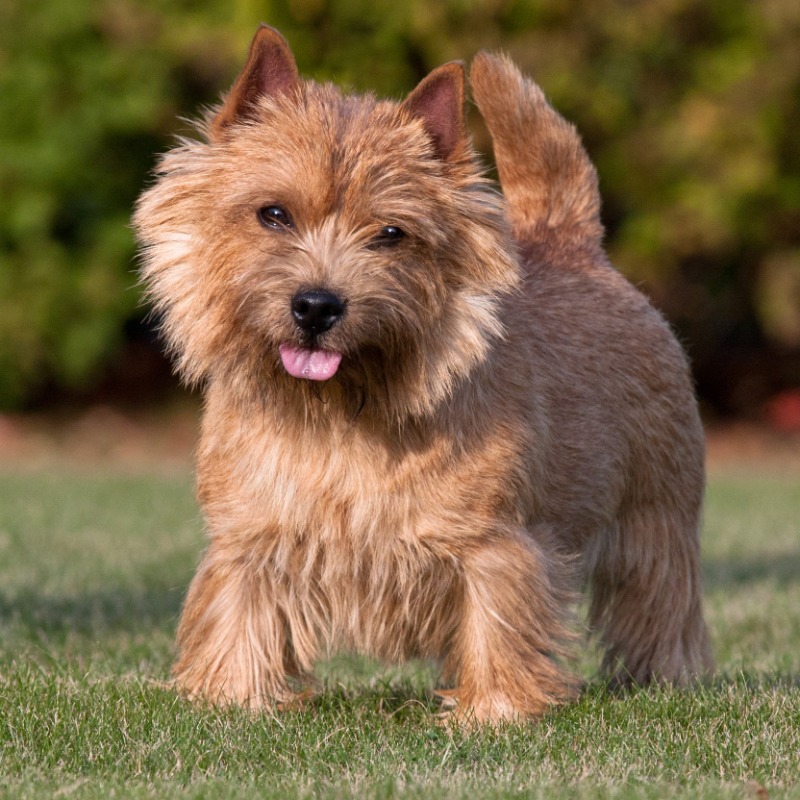Breeds
Norwich Terrier

GROUP 2 - TERRIERS
Brief History
About the 19th century a man known as “Doggy” Lawrence was breeding small terriers which he sold mainly to Cambridge undergraduates. These dogs were the foundation of what are now known as Norwich and Norfolk Terriers. The British Kennel Club in the 1930s first registered the Norwich. In 1964 the British Kennel Club divided the Norwich and the Norfolk into separate breeds based on their ear carriage. Norwich have pricked ears and Norfolks have drop ears.
Average Life Span
When considering a dog please realise that you are taking it on for its lifetime. The average life span is 16 years.
Temperament
The Norwich Terrier has a loveable disposition, is not quarrelsome, is a happy go lucky and sometimes even a bossy dog. Norwich like to be busy and love company, both human and canine. For a very small dog, Norwich are still strong and self-willed, with plenty of energy, so if you are thinking of buying a Norwich, make sure you have time for training, walking and exercising. Norwich are friendly and loyal, and they are very easy to train. They make a great watch dog, warning of anything amiss with a high pitched bark.
General Breed Description
Norwich are little, strong, compact, terriers that carry their tails up. Their rough coat can be red, wheaten, black and tan or grizzle and tan. Although small and low, they are not delicate and have good substance and bone. Their prick ears give them a sharper look than their cousin the Norfolk. They do like to dig in the garden.
Coat and Care Requirements
The coat is coarse and straight with the hair round the neck forming a ruff. The head and ears are trimmed short. A daily comb and brush is to best to keep the coat free of knots. The Norwich coat needs to be stripped or clipped twice a year to remove dead coat to allow the new coat to grow. This will stop him shedding coat. Nails need checking once a week. Teeth and ears should also be checked regularly. Norwich are busy, inquisitive little dogs, they adore walks and thrive on exercise. Special care should be taken with the dog living in town, ensuring that the dog is on a lead when leaving the garden, which must be secure.
Size
Height: 25cms (10ins).
Health
All breeds have individual health issues. When speaking to breeders it is recommended you enquire about breed health and what health testing the breeder does.
Suitability
The Norwich Terrier loves tearing around the garden with the family, or they will just simply relax on a chair with you. If you are not the boss then your Norwich will be, so beware, although he is little, he needs owners with the time to give him attention, training and exercise. As with all dogs, young children and pets should always be supervised when together.
In Conclusion
Now you know a little more about this breed. If you have decided this is the dog for you and wish to investigate further, please contact the Breed Club or Dogs Victoria. They will be able to give you information about available puppies and also suggest dog events where you can see the breed and speak to breeders. In this way you will gain a better perspective of the breed and its needs. With any breed of dog, it is important to research and determine suitability for your lifestyle before committing to a puppy which will be a part of your family for many years to come.
Whilst many breeds are recommended for families, it is imperative that when children are with dogs they are supervised at all times. Basic obedience training is a vital part of dog ownership.
Dogs Victoria is about the responsible ownership of all dogs and in particular the preservation of pure breeds.
Link to Dogs Australia Breed Standard: https://dogsaustralia.org.au/breed/detail/53
Breeders
Sorry, there are currently no breeders advertising for this breed. If you are a registered Dogs Victoria breeder and wish to advertise here please create an advertisement here.


